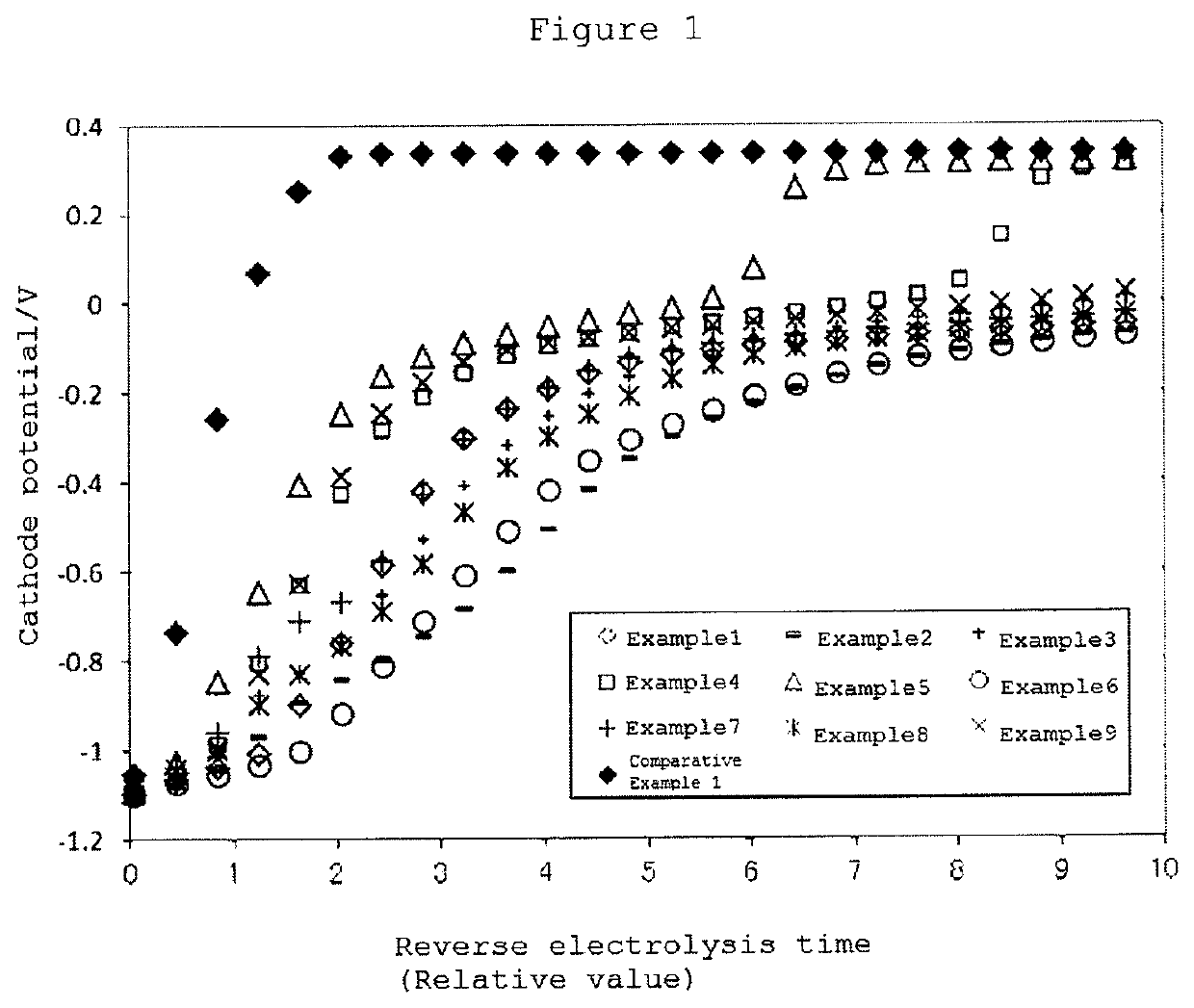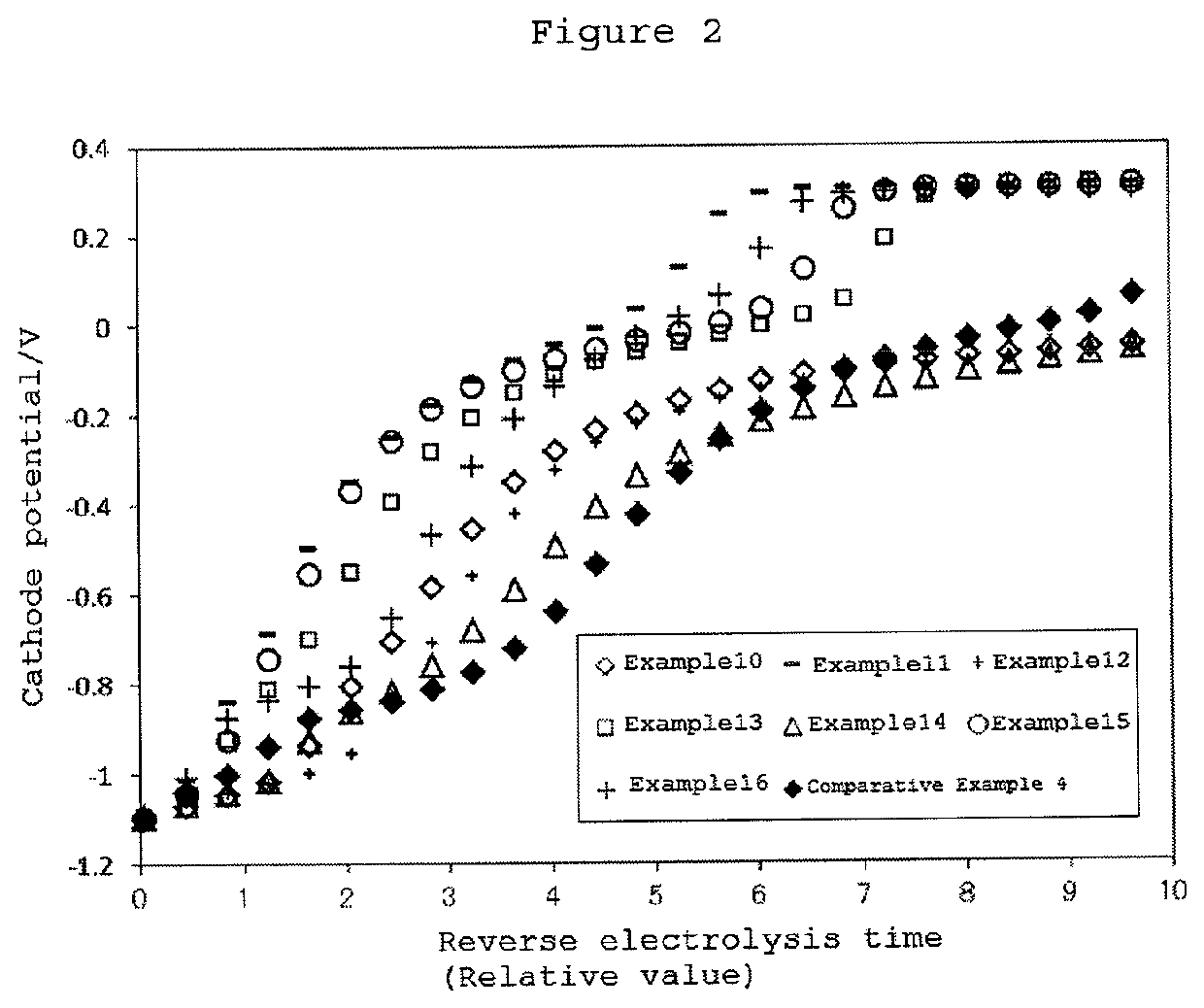Cathode for electrolysis and method for producing same, and electrolytic cell for electrolysis
a cathode and electrolysis technology, applied in the direction of electrode coating, metal/metal-oxide/metal-hydroxide catalyst, physical/chemical process catalyst, etc., can solve the problem of significant reduction in the electrolysis voltage, and achieve the effect of low hydrogen overvoltag
- Summary
- Abstract
- Description
- Claims
- Application Information
AI Technical Summary
Benefits of technology
Problems solved by technology
Method used
Image
Examples
examples
[0081]The present embodiment is described in more detail on the basis of Examples, but the present invention is not limited to these Examples. The respective evaluations were performed by the below-described methods.
[0082](X-Ray Photoelectron Spectroscopic Measurement)
[0083]An X-ray photoelectron spectroscopic measurement was performed as follows.
[0084]A test cathode was cut out to approximately 5 mm×15 mm, and the Ru 3d spectrum was measured by X-ray photoelectron spectroscopy (XPS). In this case, the test cathode was fixed in a sample holder having a recess in the lower portion thereof so as for the test cathode to bridge over the recess in order to avoid the detection of the signal from the sample holder, an X-ray photoelectron spectrometer (ESCALAB250, manufactured by Thermo Fisher Scientific Inc.) was used, and the measurement was performed under the conditions of X-ray source: monochromatized AlKα, X-ray source voltage: 15 kV, X-ray source current: 10 mA, lens mode: Large Area...
examples 1 to 16
[0099](Application Step)
[0100]As the conductive substrate, used was a woven mesh prepared by weaving nickel fine wires having a diameter of 0.15 mm so as to have a 40 mesh opening. The woven mesh was blasted by using alumina particles of JIS R6001(1998) #320, then acid treated with 6N hydrochloric acid at room temperature for 5 minutes, then washed with water, and dried.
[0101]Next, an application liquid was prepared by adding, to a ruthenium nitrate solution (ruthenium concentration: 100 g / L, manufactured by Furuya Metal Co., Ltd.), the nitric acid salt of rare earth, the second component, and the nitric acid salt(s) of at least one or more elements selected from Mn, Fe, Co, Zn, Ga, S and Pb, the third component in such a way that the metals have compositions described in Table 1 presented below. It is to be noted that with respect to S (sulfur element), thiourea was used.
[0102]A vat containing the application liquid was disposed in the lowermost part of an application roll, the app...
example 17
[0125]A cathode for electrolysis was prepared by the same method as in Example 9 except for the molar ratio of the composition, namely, with the molar ratio of Ru:Sm:Zn=1:0.25:1 wherein the addition amount of the third component element was set to be 1. When the cathode for electrolysis of Example 17 was electrolyzed at a current density of 6 kA / m2 for 7 days, the amount of ruthenium included in the catalyst layer was found to be decreased to 94% as compared with the initial value. It is to be noted that when the cathode for electrolysis of each of Examples 1 to 16 was electrolyzed under the same conditions as described above, 99% or more of ruthenium was found to remain.
[0126]The disclosure of Japanese Patent Application No. 2014-264303 filed on Dec. 26, 2014 is wholly incorporated in the present description by reference.
[0127]All the documents, patent applications, and technical specifications described in the description are incorporated in the present description by reference, t...
PUM
| Property | Measurement | Unit |
|---|---|---|
| temperature | aaaaa | aaaaa |
| temperature | aaaaa | aaaaa |
| chlorine overvoltage | aaaaa | aaaaa |
Abstract
Description
Claims
Application Information
 Login to View More
Login to View More - R&D
- Intellectual Property
- Life Sciences
- Materials
- Tech Scout
- Unparalleled Data Quality
- Higher Quality Content
- 60% Fewer Hallucinations
Browse by: Latest US Patents, China's latest patents, Technical Efficacy Thesaurus, Application Domain, Technology Topic, Popular Technical Reports.
© 2025 PatSnap. All rights reserved.Legal|Privacy policy|Modern Slavery Act Transparency Statement|Sitemap|About US| Contact US: help@patsnap.com



